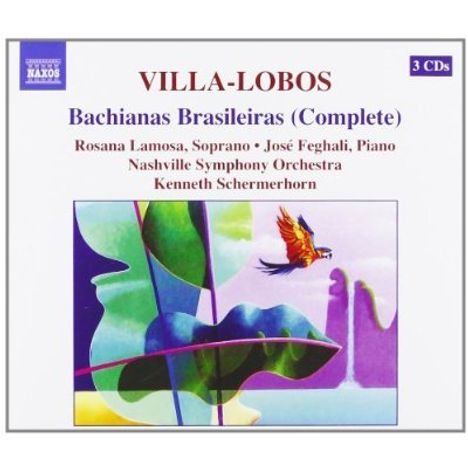Heitor Villa-Lobos: Bachianas Brasileiras Nr.1-9 auf 3 CDs
Bachianas Brasileiras Nr.1-9
Herkömmliche CD, die mit allen CD-Playern und Computerlaufwerken, aber auch mit den meisten SACD- oder Multiplayern abspielbar ist.
Lassen Sie sich über unseren eCourier benachrichtigen, falls das Produkt bestellt werden kann.
(Nr. 1 für 8 Celli; Nr. 2 für Kammerorchester; Nr. 3 für Klavier & Orchester; Nr. 4 für Orchester; Nr. 5 für Sopran & 8 Celli; Nr. 6 für Flöte & Fagott; Nr. 7 für Orchester; Nr. 8 für Orchester; Nr. 9 für Streicher)
- Künstler:
- Lamosa, Feghali, Marchina, Gratton, Estill, Nashville SO, Schermerhorn, Mogrelia
- Label:
- Naxos
- Aufnahmejahr ca.:
- 2004/2005
- UPC/EAN:
- 0747313246021
- Erscheinungstermin:
- 24.10.2005
- Serie:
- Naxos Latin American Classics
Ähnliche Artikel
Es ist keine Übertreibung zu sagen, dass Heitor Villa-Lobos die brasilianische Musik auf die kulturelle Weltkarte gebracht hat. Doch der Komponist, der weite Reisen in Südamerika und der Karibik unternahm und ethnische Idiome aus erster Hand aufnahm, gewann auch bei vielen europäischen Musikern nachhaltigen Respekt für seine innovative Musik. Nachdem Villa-Lobos die meiste Zeit der 1920er Jahre in Paris verbracht hatte, kehrte er im Juni 1930 nach Brasilien zurück. Bald darauf stürzte Getúlio Vargas die Alte Republik und leitete eine Umgestaltung der brasilianischen Institutionen ein. Angesichts seiner Referenzen als Komponist und Organisator war es keine Überraschung, als Villa-Lobos 1932 eingeladen wurde, die Leitung der Musikausbildung in Rio de Janeiro zu übernehmen. Dies veranlasste ihn dazu, das anspruchsvolle Idiom, das er in Paris kultiviert hatte, zu meiden, denn dort wurden brasilianische Volks- und Volkstümereinflüsse in den Vordergrund gestellt.
Nirgendwo wird dies deutlicher als bei den Bachianas brasileiras. Diese Stücke reichen von Instrumental- und Kammermusik bis hin zu großen Orchesterwerken und erhalten ihren Schwerpunkt dadurch, dass sich die brasilianischen Ausdrucksformen mit harmonischen und kontrapunktischen Techniken verbinden, die direkt aus der Barockzeit stammen. Seit seiner Jugend war Villa-Lobos von Bach fasziniert und fand in seinem Werk Analogien zur traditionellen Musik Brasiliens. Daher war die vorliegende Sequenz als explizite Hommage an Bach gedacht, was am deutlichsten in der Bezeichnung fast aller Sätze mit Doppeltiteln zum Ausdruck kommt, die sowohl auf die eigentlichen Sätze der barocken Suitenformen als auch auf spezifische brasilianische Volksstile anspielen.
Product Information
It is no overstatement to say Heitor Villa-Lobos put Brazilian music on the cultural map. Yet the composer who travelled widely in South America and the Caribbean, absorbing ethnic idioms at first hand, also won lasting respect from many European musicians for his innovative music. Having spent most of the 1920s based in Paris, Villa-Lobos returned to Brazil in June 1930. Soon after, Getúlio Vargas overthrew the Old Republic and embarked on a transformation of Brazilian institutions. Given his credentials as composer and organizer, it was no surprise when, in 1932, Villa-Lobos was invited to take charge of music education in Rio de Janeiro. This led him to eschew the sophisticated idiom he had cultivated in Paris for one where Brazilian folk and popular influences were made paramount.
Nowhere is this more apparent than in the Bachianas brasileiras. These pieces range from instrumental and chamber to large orchestral forces, and are given focus through the Brazilian idioms being wedded to harmonic and contrapuntal techniques directly derived from the Baroque era. From his adolescence Villa-Lobos had been fascinated by Bach, finding in his work analogies with the traditional music of Brazil. Thus the present sequence was intended as an explicit homage to Bach, a factor most evident in the designation of almost every movement with twin titles alluding both to the actual movements of Baroque suite forms and also to specific Brazilian popular styles.
Disk 1 von 3 (CD)
-
1 Bachianas brasileiras No. 1: I. Introduction: Embolada
-
2 Bachianas brasileiras No. 1: II. Preludio: Modinha
-
3 Bachianas Brasileiras No. 1: Iii. Fugue: Conversa (Conversation)
-
4 Bachianas brasileiras No. 2, "O trenzinho do Caipira" : I. Preludio: O Canto do capadocio (Scamp#s Song)
-
5 Bachianas brasileiras No. 2, "O trenzinho do Caipira" : II. Aria: O Canto da nossa terra (Song of Our Land)
-
6 Bachianas Brasileiras No. 2, "o Trenzinho Do Caipira" : Iii. Danza: Lembranca Do Sertao (Remembrance Of The Bush)
-
7 Bachianas brasileiras No. 2, "O trenzinho do Caipira" : IV. Toccata: O trenzinho do Caipira (The Peasant#s Little Train)
-
8 Bachianas brasileiras No. 3: I. Preludio: Ponteio
-
9 Bachianas brasileiras No. 3: II. Fantasia: Devaneio (Digression)
-
10 Bachianas Brasileiras No. 3: Iii. Aria: Modinha
-
11 Bachianas brasileiras No. 3: IV. Toccata: Picapu
Disk 2 von 3 (CD)
-
1 Bachianas brasileiras No. 4: I. Preludio: Introducao
-
2 Bachianas brasileiras No. 4: II. Coral: Canto do Sertao (Song of the Bush)
-
3 Bachianas Brasileiras No. 4: Iii. Aria: Cantiga
-
4 Bachianas brasileiras No. 4: IV. Danza: Miudinho
-
5 Bachianas brasileiras No. 5: I. Aria: Cantilena
-
6 Bachianas brasileiras No. 5: II. Danza: Martelo
-
7 Bachianas brasileiras No. 6 : I. Aria: Choro
-
8 Bachianas brasileiras No. 6 : II. Fantasia
Disk 3 von 3 (CD)
-
1 Bachianas brasileiras No. 7: I. Preludio: Ponteio
-
2 Bachianas brasileiras No. 7: II. Giga: Quadrilha Caipira (Country Quadrille)
-
3 Bachianas Brasileiras No. 7: Iii. Toccata: Desafio (Joust)
-
4 Bachianas brasileiras No. 7: IV. Fuga: Conversa (Conversation)
-
5 Bachianas brasileiras No. 8: I. Preludio
-
6 Bachianas brasileiras No. 8: II. Aria: Modinha
-
7 Bachianas Brasileiras No. 8: Iii. Toccata: Catira Batida
-
8 Bachianas brasileiras No. 8: IV. Fuga
-
9 Bachianas brasileiras No. 9: I. Prelude: Vagaroso e mistico
-
10 Bachianas brasileiras No. 9: II. Fugue: Poco apressado
Mehr von Heitor Villa-Lobos
-
Heitor Villa-LobosSämtliche Symphonien7 CDsAktueller Preis: EUR 39,99
-
Tilman Hoppstock - Great Preludes for GuitarCDAktueller Preis: EUR 6,99
-
Asya Fateyeva - BachianaCDAktueller Preis: EUR 19,99
-
Khatia Buniatishvili - LabyrinthCDVorheriger Preis EUR 19,99, reduziert um 0%Aktueller Preis: EUR 12,99











